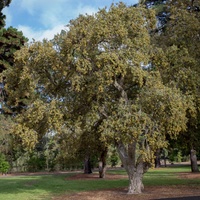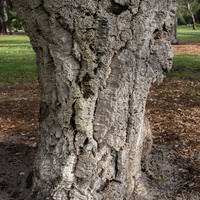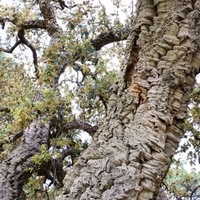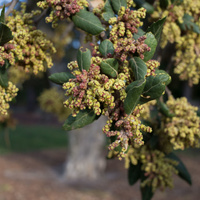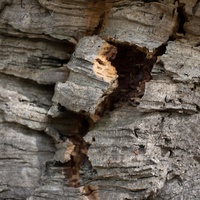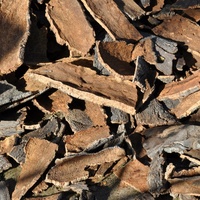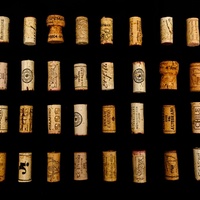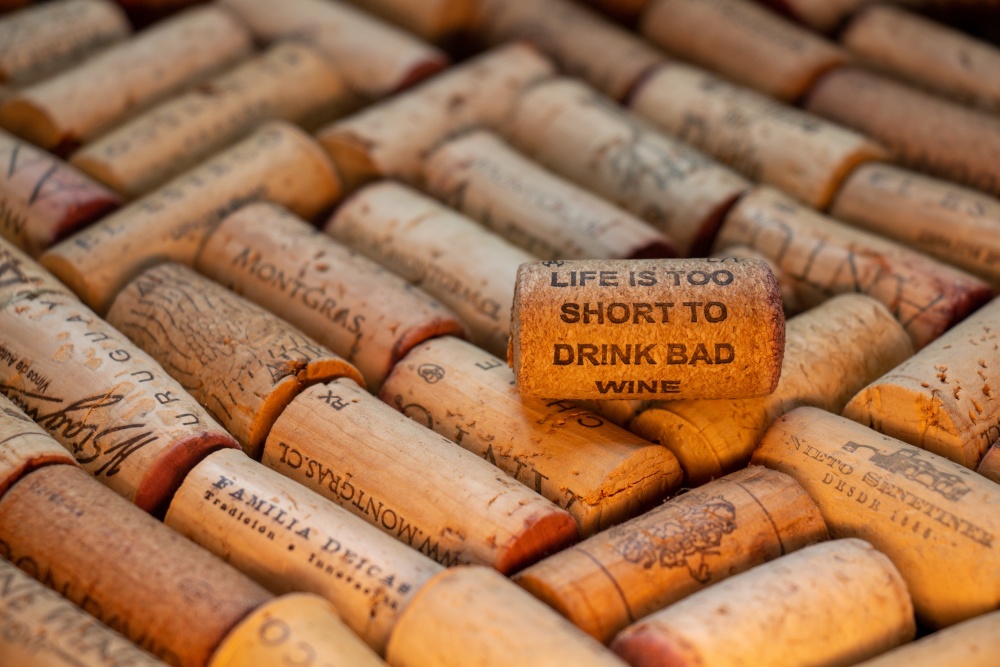Common name: Cork Oak
Description
Cork Oak is a long-lived, semi-evergreen tree originating in the Mediterranean region, its natural range extending from Portugal, through Spain and North Africa, to southern coastal France and Italy. As its name suggests, it is the source of commercial cork, which comes from its bark.
It is a slow-growing tree, to heights of up to 25 m (80 ft) with a trunk diameter of 1.2 m (4 ft). However, it is more typically 10 to 20 m (30 to 60 ft) tall, with a stout trunk supporting a sizeable rounded crown. The trunk and main branches are covered in light-grey bark that is gnarly, rough and up to 10 cm (4 in) thick.
Leaves are oval, small, 2 to 8 cm (1 to 3 in ) long, serrated on the margins, dark glossy green on top and dull grey underneath. They remain on the tree in all seasons, though some leaf fall occurs during extreme dry or cold periods.
Flowers are small and insignificant, yellow, either female or male on the same tree and in catkin-like clusters arising at the ends of the branches. They bloom in spring, at which time the male flowers release their pollen, which gets carried by the wind to pollinate the female flowers.
Fertilised female flowers develop into a hard nut commonly known as an acorn, which is egg-shaped, dark green and half-covered by a bowl-shaped cap. Enclosed is a single, oil-rich seed, though occasionally there may be two or even three seed inside.
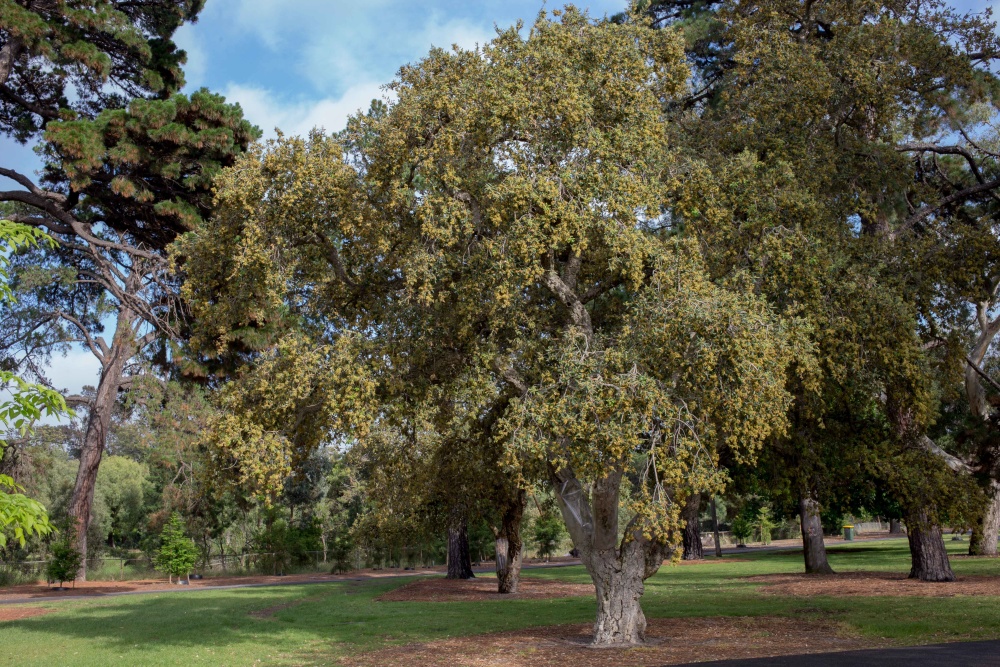
Cork Oak tree (Melbourne, Australia)
Use
Cork Oak bark has been harvested for centuries as commercial cork, traditionally for making cork stoppers to seal bottles filled with liquids such as wine and olive oil.
Nowadays, cork is used to make bottle stoppers and a diverse range of products, including panels for heat and sound insulation, friction and vibration pads, seals, and buoyancy material for flotation devices, including surfboards. Cork is lightweight, weighing around 225 kgs per cubic meter (14 lbs per cubic foot), which is lighter than water and therefore floats. Only Balsa (Ochroma pyramidale) is lighter at 128 to 192 kgs per cubic meter (8 to 12 lbs per cubic ft).
Granulated cork, made from leftover material, for example, cork stopper manufacture, is combined with rubber from the Rubber tree (Hevea brasiliensis) to make cork/rubber composites that are lightweight, compressible and flexible. Easily moulded and shaped, they are made into sealed gaskets used in automotive engine blocks, vibration pads, oil retainers, polishing wheels, roll coverings, linoleum for floor coverings, shoe soles and packaging for perishables products such as fruit.
Although cork stoppers represent only 15 to 20% of cork usage by volume, it accounts for 75 to 80% of its market value.
The acorns can be roasted and eaten but are more usually left to fall to the ground to be foraged by pigs. Acorn-fed, Black Iberian pigs found in Spain and Portugal produce one of the world's most prized and expensive hams. Known locally as 'Jamon iberico', its reputation and popularity have spread worldwide.
Cork Oak is sometimes planted in urban areas as an amenity, street or shade tree.
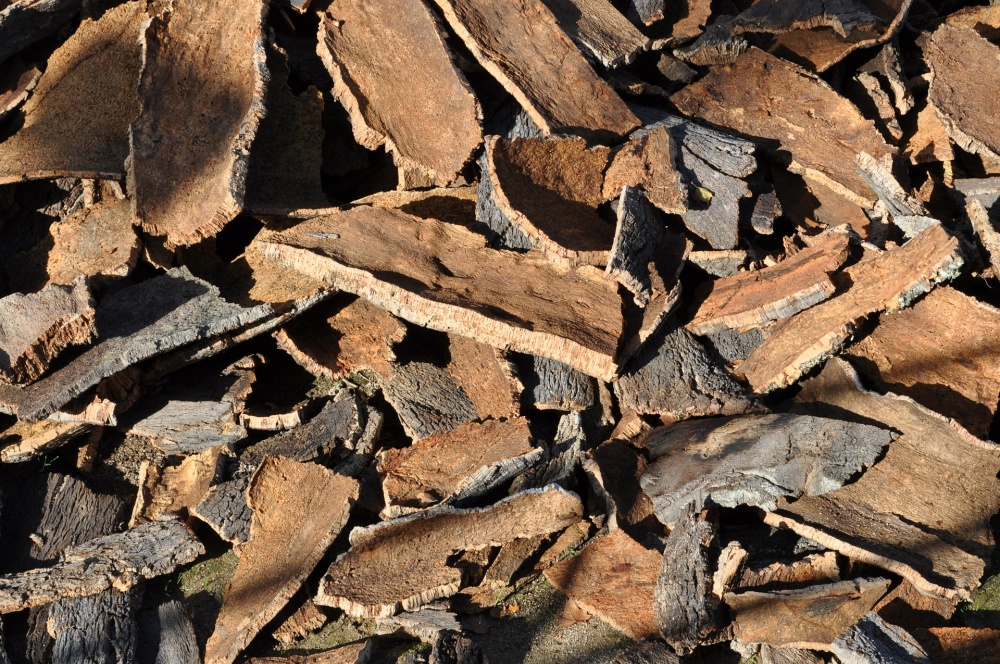
Climate
Cork Oak grows naturally and produces quality cork in Mediterranean climates. Generally, areas with annual lows of 6 to 17°C, annual highs of 19 to 32°C, annual rainfall of 600 to 1100 mm and a summer dry season of 7 months or less, extending to 12 months with irrigation or groundwater.
Although the trees also grow well in areas with summer and uniform rainfall patterns - such as Eureka, California; London, England (e.g. the Chelsea Physic Gardens); Wellington, New Zealand; Kruger National Park, South Africa, and Australia, in Hobart, Canberra, Melbourne, Bowral and Tenterfield - the quality of the cork produced is inferior to cork coming from areas with a distinct summer dry season. Wet conditions at the wrong time also make the tree susceptible to disease.
The best quality cork comes from warm Mediterranean regions with a pronounced summer dry season and average highs of the warmest month above 25°C (77°F). Slow rates of bark growth, caused by low water availability during the active growing season, result in a fine-textured cork with a dense cell structure suitable for making high-value products such as cork stoppers for wine and champagne bottles.
Growing
New plants are usually started from acorns that benefit from being soaked in water for a couple of days to improve their germination. Any acorns that float are discarded, leaving only the healthy acorns that are then sown directly in the soil where the tree will grow. Direct sowing allows the seedlings to develop a good root system quicker than if transplanted, thereby increasing their chances of surviving their first dry summer season.
Performs best on deep, free-draining loam, sandy-loam, loamy-sand and gravelly soils of a moderately acid to neutral nature, generally with a pH of 5.0 to 7.0, and on sites with full to partial sun exposure. Cork Oak trees are tolerant of drought conditions but intolerant of excessive moisture, which increases the tree's suitability to disease and may also cause the bark to rot.
Cork harvest occurs late spring to summer when the tree is actively growing and the cork, or outer bark, separates from the inner bark, making it easy to peel off without damaging the tree. Underneath the gnarly surface is the pale red-brown, corky, and spongy layer that is the cork of commerce.
The trees are around twenty-five years old when first harvested for their cork. After that, they are stripped every 9 to 12 years. And because they live for up to 150 years, they can be harvested around 12 times over their lifetime. However, cork from young trees is inferior, being hard, irregular, and generally unsuitable for making cork stoppers used to seal wine and champagne bottles. Only from the third harvest on is premium-quality cork obtained.
Cork trees produce an average of 40 to 60 kg (88 to 132 lbs) of usable cork. But before making anything with it, it has to be dried for six months or more and then steamed to soften it, make it more flexible, and kill any insects.
While most cork comes from natural forests, it's important to note that the highest concentrations of trees are in plantations, such as those in São Brás de Alportel, in the Algarve region of Portugal. These carefully managed plantations serve as a testament to the industry's commitment to sustainability and the preservation of natural resources.
Problem features
Cork Oak pollen is known to cause allergies or hay fever in some people.
The spent flowers and fallen acorns are known to produce litter.
Where it grows
References
Books
-
Brady, G. S. & Clauser, H. R & Vaccari, J. A. 2002, Materials handbook : an encyclopedia for managers, technical professionals, purchasing and production managers, technicians and supervisors, 15th ed., McGraw-Hill, New York
-
Crane, E., Walker, P. & Day, R. 1984, Directory of important world honey sources, International Bee Research Association, London
-
Editors of Sunset Magazine 2012, The New Western Garden Book: The Ultimate Gardening Guide, 9th edition, Sunset Publishing Corporation, California
-
Gilman, E. F. 1997, Trees for urban and suburban landscapes, Delmar Publishers, Albany, New York
-
Jelks, Mary 1986, Allergy plants : that cause sneezing and wheezing, 1st ed., World-Wide Publications, Tampa, Florida
-
Menninger, E. A. 1967, Fantastic trees, Viking Press, New York
-
Menninger, E. A. 1977, Edible nuts of the world, Horticultural Books, Stuart, Florida
-
Randall, R. P. 2002, A global compendium of weeds, R.G. and F.J. Richardson Press, Melbourne
-
Streets, R. J. & Troup, R. S. 1962, Exotic forest trees in the British Commonwealth, Oxford University Press, Oxford, England
-
Tudge, C. 2006, The secret life of trees : how they live and why they matter, Penguin, London
-
Wickens, G. E 1995, Edible nuts, Food and Agriculture Organization of the United Nations (FAO), Rome
